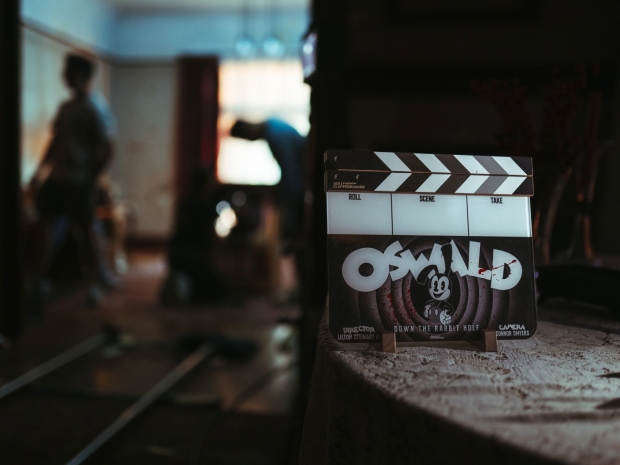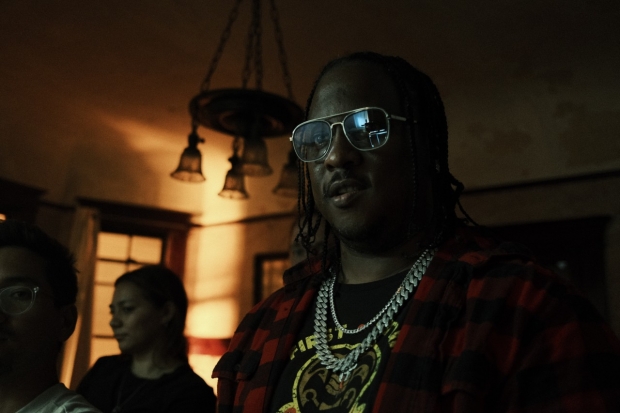The director explains that while his movie is mainly advertised as a horror film, ‘It leans more heavily into adventure and fantasy’ and ‘feels more like ‘The Goonies’ with young adults,’ also noting that with a mix of 2D animation and VFX, it tackles ‘the dark side of nostalgia, and how it can lead to depression and trauma.’
A few weeks ago, the world caught its first glimpse of the upcoming flick Oswald Down the Rabbit Hole when a first look announcement trailer was dropped. Striking while the public domain anvil is hot, Lilton Stewart III, the award-winning American filmmaker behind November 11th Pictures, has teamed with producer Lucinda Bruce, owner of Lady of the Light Productions, for a sinister take on an iconic cartoon classic. The film is produced in partnership with Mana Animation Studio for animation, Crop Circles Studios for VFX, and Tandem Post House for post-production.
Oswald follows main character Art and his friends as they track down his long-lost family lineage. However, when they find his Great-Grandpa Oswald’s abandoned home, they are transported to a place lost in time, and must work together to escape their magical prison before the Rabbit gets to them first.
AWN recently sat down with director Stewart to discuss the making of the film, as well as the process of bringing fantasy moments and effective horror elements to the big screen through VFX and animation.
Check out the film’s teaser first:
The film, which was inspired by a late-night viewing of Winnie-the-Pooh: Blood and Honey at Cinemark North Hollywood, has been in gestation for over a year. “The first few months were me figuring out the world and how it works, which will ultimately turn out to be the lore bible,” Stewart explains. “I then created the characters and their backstories, defining who they are as well as their goals. Then, it was time to tackle the story, developing and building an extensive outline and treatment. Afterwards I started writing the script, and that took me a little under two weeks to complete the first draft. All that was done within the first 90 days or so. I’ve spent the rest of the time even as of today, chiseling away at everything to refine and get the script in the best position I can before we film.”
While Oswald is currently in development, funding is still a factor for the horror flick. “Our active plans for financing the film are looking for investors to assist and/or find a studio to pick up the film,” Stewart says. “We have done a lot of heavy lifting, putting the teams together, scouting locations, building shotlists, and more to put the film in a prime position for success.”
AWN was especially curious if the team had faced any issues from Disney for using the Oswald character, despite it entering the public domain January 1 of last year. “There haven’t been any issues because we have taken serious precautions to respect all existing copyrights,” assures Stewart. “Technically, our rabbit is an original character. From head to toe, our design has numerous differences that separate from non-public domain copyrights. The things it can do differ from the original Oswald the Lucky Rabbit. In our film, Oswald is a man, a cartoon/animation artist who creates the nameless rabbit. It’s a Frankenstein move, aka Frankenstein’s Monster (though most people always call the monster Frankenstein.) We ran the lore bible and screenplay by our lawyer multiple times until their professional written opinion favored us. We are also only using the public domain Trolley Troubles cartoon as a genie bottle. Everything else about the film is only inspired by the public domain version of Oswald the Lucky Rabbit.”
As for the actual plot of the film, Stewart reveals, “The story is huge, and the first film barely scratches the surface. Even though it's technically a horror film, it leans more heavily into adventure and fantasy. Art and his friends' journey feels more like The Goonies with young adults. There will be fantastical moments taking place in very grounded situations. The horror elements, while extremely creative and satisfying when they happen, take a back seat to the rich character study taking place.”
“We tackle the dark side of nostalgia, and how it can lead to depression, trauma, and how chasing the past can be harmful,” Stewart continues. “I want people to love and relate to these characters. We spend most of the story developing and flushing out these wonderful characters, which genuinely affect the audience when they are inevitably in peril.”
 With such an emphasis on fantasy moments and effective horror elements, VFX plays a very crucial part in the film. “For example, Art ‘sees’ things that require his reality to be challenged on a visual front; the world they are transported to through the TV looks dream-like, familiar yet logically shouldn’t be able to exist, and Oswald’s Rabbit has insane powers constantly on display, so Bob Homami and Crop Circle Studios will be making sure all of these elements add to the story, not distract from it,” the director reveals.
With such an emphasis on fantasy moments and effective horror elements, VFX plays a very crucial part in the film. “For example, Art ‘sees’ things that require his reality to be challenged on a visual front; the world they are transported to through the TV looks dream-like, familiar yet logically shouldn’t be able to exist, and Oswald’s Rabbit has insane powers constantly on display, so Bob Homami and Crop Circle Studios will be making sure all of these elements add to the story, not distract from it,” the director reveals.
“We are currently circling ideas on how to use pcap and mocap on set and sound stages to bring Oswald’s Rabbit to life, combining traditional 2D animation with 3D rigged models,” Stewart adds. “We want the rabbit to be able to fully interact with the world and its inhabitants while maintaining that late 20s and early 1930s rubber hose animation.”
Speaking further about how the visuals will be achieved, CEO/Founder of Crop Circle Studios and VFX supervisor Bob Homami says, “The first step will be developing the look and feel of the rabbit in both the physical/magical world as well as the cartoon world. Working closely with Lilton and Jorik, we’ll set the look of each world as a roadmap before production begins.”
Homami adds, “We plan to use a hybrid production approach to complete the film. Traditional principal photography, in addition to virtual production, will be utilized. We’re currently determining which approach would best fit each scene in the film and may adjust if the methodology affords more flexibility to lean one way versus the other.”
“For the rabbit in the physical/magical world, we will film clean plates, as well as a reference to the scripted performance by an actor,” he continues. “We will capture the HDRI reference of the set for lighting reference as well as camera and lens information. The rabbit will need to have three-dimensional volume but will need to look very two-dimensional, so highlight and shadow will be simple but appropriate to the scene.”
“For the scenes with the rabbit, the post-production will consist of two methodologies: one will be traditional (2D) ink and paint style animation, and the other will be standard VFX methodologies,” Homami concludes. “For the VFX, we will track each plate and animate the CG (computer-generated) rabbit. We will light and composite the rabbit into the scene and may circle back around for additional elements created by the 2D animation team. The 2D animation team will spearhead the cartoon world of the rabbit scenes.”









